Foundation Crack Repair
If Your Home Has a Basement, You Probably Have a Crack in the Foundation
The vast majority of foundations, regardless of what they are made of, will develop some type of crack or damaged area. The experts at Reliable Basement are here to solve these types of problems. We can correctly diagnose the issue and offer a wide array of services to help alleviate your concerns about structural damage, water intrusion, repair costs and more. We take the time to create a custom solution for every home and project. While many situations may be similar, no two properties are the same. We care about making sure our customers understand our process and that they receive the information they need when it comes to making decisions about Foundation Crack Repair.
Reliable Basement Services is a prominent foundation crack repair company for the Chicagoland area. If you need a crack inspected, assessed, and repaired, we are the company to do it. We do all kinds of basement sealing, but crack repair is by far our most common service. We have filled thousands of foundation cracks over the past 10+ years.
We offer a variety of crack repair services and products to help you deal with any situation. We can do interior and exterior crack repairs. We perform polyurethane injections and epoxy injections. We use carbon fiber and steel for cracks that present structural problems. We can do it all!
Every crack repair project is different, but for interior foundation crack injections we follow a similar process:
- Prep the wall by chiseling or grinding paints, previous repairs, or other substances to expose bare concrete
- Drill into the crack on a diagonal angle to cross the crack roughly half way through the wall every 6-12″ along the length of the crack
- Install injection ports in each of the drilled holes. Tighten to secure.
- Apply a 2-part epoxy roughly 4″ wide along the length of the crack to seal the interior face of the crack
- Using a crack injection machine inject liquid polyurethane into each port to fill the crack completely from the soil on the outside to the epoxy face patch we applied on the interior
Just like our interior process every exterior crack repair is slightly different, so for exterior foundation crack repairs we follow a similar process on each one:
- Excavate a man-sized hole from grade level to the footing in front of the crack
- Clean and prep the exterior of the foundation wall
- Apply a liquid membrane directly to the foundation wall
- Install a sheet membrane on top of the liquid membrane
- Secure the repair with termination strips mechanically fastened to the foundation wall
- Backfill the displaced soils
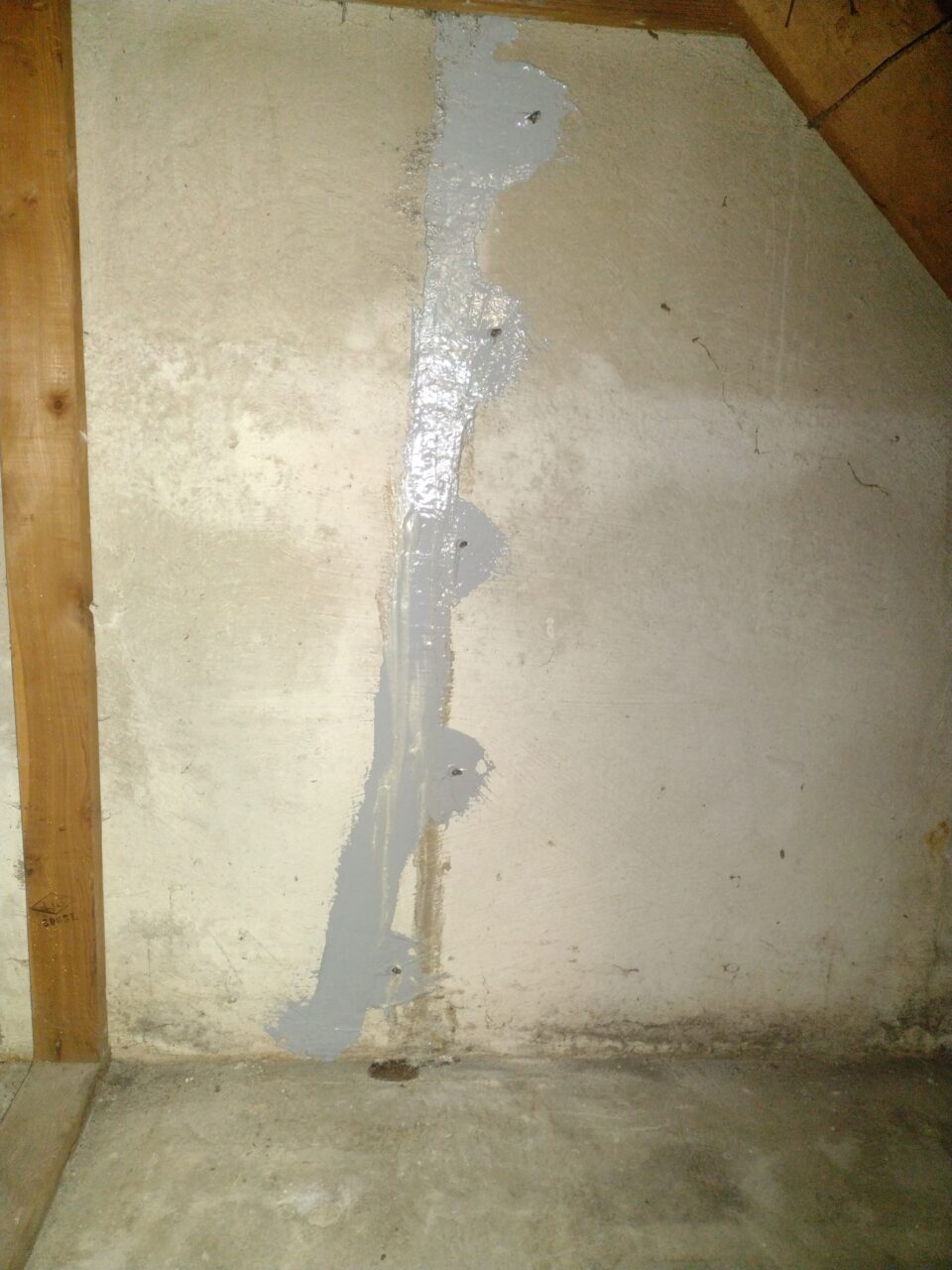
Interior Foundation Crack Injections
There are a wide variety of repair methods out there to repair cracks. Some are better than others. You will see old crack repairs that just have a layer of hydraulic cement smeared over them, and while we know now that this doesn’t work long term when this style of repair was done 20-30 years ago it may have been the best option available. If you have done any research on the subject you will likely see many arguments for or against all repair methods.
At Reliable Basement Services we use a high pressure polyurethane injection. We believe this is the best repair method currently available for foundation cracks. We believe in our process and demonstrate this belief by offering a LIFETIME, TRANSFERRABLE with every interior crack injection. Polyurethane is an expanding, hydrophilic (reacts to water), and flexible material that will fill in all the tiny nooks and cranny’s of a foundation crack that can let water into your basement. We inject using a machine so that we create enough pressure to push material all the way to the outside of the foundation wall. If water can still get into any portion of a crack the repair can fail.
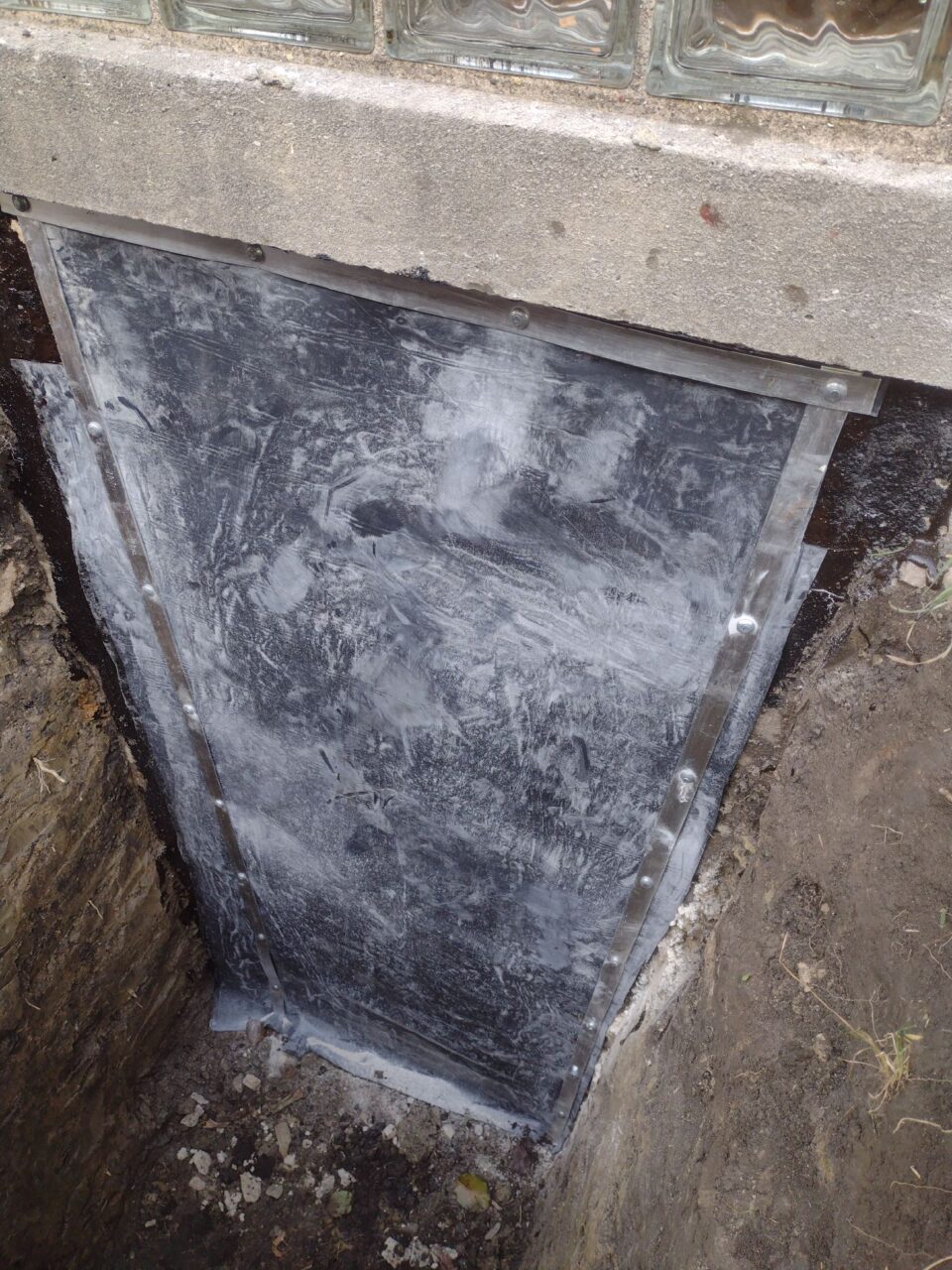
Exterior Foundation Crack Repairs
Just like interior crack repairs you will see a wide variety of repair methods for treating cracks from the outside. In our opinion there are ALOT of ways to do it wrong. You will see information about bentonite clay which is a good product, but is often misused and misrepresented. Some people doing DIY repairs think they just need to cover the part of the crack they can see (ironically the only part you don’t need to seal). Just like old interior repairs you will see plenty of hydraulic cement just slathered over the exterior portion of foundation cracks. Again, there are lots of way to do it wrong. Let Reliable Basement Services complete your exterior foundation crack repair correctly.
While it is more work and more time consuming, our repair method is superior to the vast majority of the competition. We excavate to expose the entire crack so we can see what we’re dealing with. One major drawback of bentonite is that there is no guarantee you cover the entire crack if the crack moves right or left as it travels down the wall, which many of them do! We get a good view of the situation and are able to apply 2 layers of protection exactly where it needs to go. The liquid membrane and sheet membrane we install offer complete, secured protection.
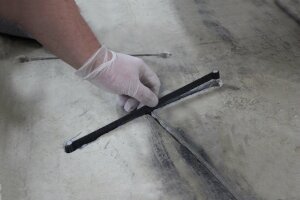
Carbon Fiber Products
Sometimes when cracks have been ignored for too long or the foundation movement that caused them is extreme they can become structural problems. Once cracks reach certain milestones based on size, shape, path, deflection etc. they become a greater cause for concern that just water. At Reliable Basement Services we take pride in our ability to diagnose and treat the structural issues that other companies don’t want to deal with. When it comes to structural foundation cracks we turn to carbon fiber.
Carbon Fiber is an extremely versatile material that comes in many forms and can be applied many ways. The most common carbon fiber product that we use are the Carbon Fiber Staples. These crack lock staples are great for cracks that are wider than 1/8″. Once a crack achieves this width there is a lot less friction between the wall sections to prevent future movement. Reliable Basement uses carbon fiber products to mitigate the risk of future motion.
We also install rolls of carbon fiber fabric in a variety of widths and lengths to deal with trickier foundation repairs. Consult with a representative from our sales team to get more information and find out if your foundation issues require these types of products.
Epoxy or Polyurethane Injection?
Epoxy and polyurethane are two types of injections that Reliable Basement Services use to fix basement cracks. Often when we are repairing a cracked foundation, either option would work. But there are some general guidelines that help us decide which type of injection to use. If your crack needs to be structurally repaired, and the area needs to be strong or at least stronger than the concrete around it, epoxy is the right choice. But if you need to repair the crack solely to prevent water leakage or to prevent the crack from actively leaking, a polyurethane injection is the best choice. Consider these benefits of both materials. In addition, many of the benefits and functions of epoxy can be achieved using carbon fiber products in addition to a regular urethane injection.
POLYURETHANE CRACK INJECTION
If the main concern with your basement is a water leak, polyurethane foams are the best choice. Polyurethane foams are elastomeric and set quickly, which makes them the most effective solution for waterproofing when there is no need for a structural repair. Because of its expansive properties, this material will get into even the smallest crevices. The elastomeric nature also allows polyurethane to accommodate slight concrete movements. Even with age, this seal will stay intact.
Polyurethane begins to cure in just minutes! This means there are fewer chances for the material to flow out of an injected crack when it’s still in its liquid form. Even if some of the polyurethane does leak, it will foam and expand to fill the void. Urethane is perfect for basic foundation crack filling. It adds almost zero compression strength, but this isn’t needed when repairing a cracked foundation in most residential applications.
Polyurethane can also be combined with carbon fiber products to get the structural benefits of an epoxy injection, but the waterproofing benefits inherent with polyurethane.
EPOXY CRACK INJECTION
Epoxies have an incredible compressive strength of 12,000 psi or more—that’s even stronger than most concrete! This makes epoxies a great choice for cracks that require structural repair. However, epoxies cure very slowly. It usually takes them hours to harden, which means it’s possible for the epoxy to flow out of the backside of the crack before it has hardened. This will only happen if the backfill outside the wall has separated from the foundation. Epoxy does have its place in the waterproofing world, but the improvements in Carbon Fiber have made some of its use cases obsolete.
Superficial Repairs & Do-it-Yourself Kits
ARE NOT Professional Crack Repairs
Many homeowners may be tempted to use caulk or hydraulic cement to patch concrete cracks. These products are only a temporary solution for repairing a cracked foundation at best. It’s superficial and won’t prevent water from entering and ending up behind the material. The result of this is efflorescence. The white chalky substance commonly found on masonry that is always damp. Eventually, the caulk will crack and peel off, which will expose a crack that has enlarged from freezing and erosion. If it doesn’t crack and peel off on its own the water will eventually do it anyway. Hydraulic cement does not bond well and adhere long term. It also leads to water entering the wall but being held back once inside, again results in efflorescence. Eventually, water and time will dislodge the cement plug.
Reliable Basement Services has a success rate of nearly 100% when it comes to Chicago foundation repair. We are so confident in our manufacturers and our staff that we offer a lifetime warranty on all our interior injection repairs. We are dedicated to your satisfaction.
A do-it-yourself basement crack repair kit is never a good substitute for hiring a Chicago foundation repair company. These kits won’t provide you with the money back guarantee or the professional high-quality service you’ll get with Reliable Basement Services. If you are looking to sell your home, the buyer will most likely require you to give them warranties of the work you’ve had done. If you opt to use the do-it-yourself kit, you won’t be able to provide that.
How to Evaluate and Diagnose Foundation Cracks
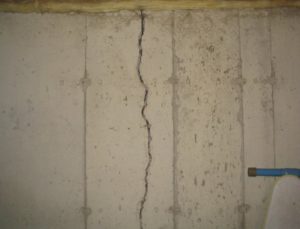
Vertical foundation cracks (shrinkage cracks) are the most common and "least" concerning types of cracks. All cracks are an issue, this type of crack is just the easiest to deal with. They are sometimes v-shaped—wider at the top of the wall and then diminishing or stopping before reaching the bottom of the foundation wall. This is less common. If you have a wall crack that goes all the way into the floor, it may involve the building footings and may be a settlement crack that is damaging the structural integrity of the building.
While it is curing, concrete shrinks. With poured concrete, this shrinkage causes cracks. It’s common for there to be minor shrinkage cracks that are hairline, random, intermittent, and meandering in the concrete. If the concrete was not properly mixed, or if control joints were omitted, the shrinkage cracks will be larger and appear more frequently. Sometimes cracks form because of the omission of or the placement of steel reinforcements (tie-rods).
Most of the time shrinkage cracking is a result of a poor concrete mix, rapid curing process, or other factors with the original construction. It’s less likely that shrinkage cracks will require structural maintenance or repairs because these cracks aren’t expected to continue to change after the initial curing.
We say these cracks are "least" concerning because they are generally NOT structural in nature. They can be, but usually are not. When compared to horizontal and diagonal cracks, which generally ARE structural in nature. Most simply require waterproofing by doing an interior crack injection.

There are many clues that help diagnose the probable cause of diagonal foundation cracks in buildings. Here are some of the most common.
Some cracks extend from the corner of a wall towards an adjacent opening and are wider at the top than the bottom. Usually, these are caused by foundation settlement, expansive clay soil, frost damage, or damage from a shrub or tree close to the wall.
Some cracks originate under a ground floor window and extend from the sill to ground with the sill bowed up. These cracks are often due to foundation heave, clay soil, frost, shallow or absent footings.
If you live in a colder climate, you may have a crack in a corner of your home. Frost heave, frost lensing, shallow footings, water problems, or insufficient backfill could have caused these.
Vertical or diagonal cracks that open SUDDENLY after rain are serious problems. They can be caused by the settlement of the structure over sinkholes.
Sometimes straight or diagonal cracks appear over windows or doors. They could appear as horizontal along the top or bottom of the header and vertical at the ends of the header. This may be due to differences in thermal expansion between the header materials and the wall materials. These cracks could also be either vertical or diagonal at the center of the header or the corners, which is a loading failure. If the cracks are vertical or diagonal at the corners, this could be a point-load failure.
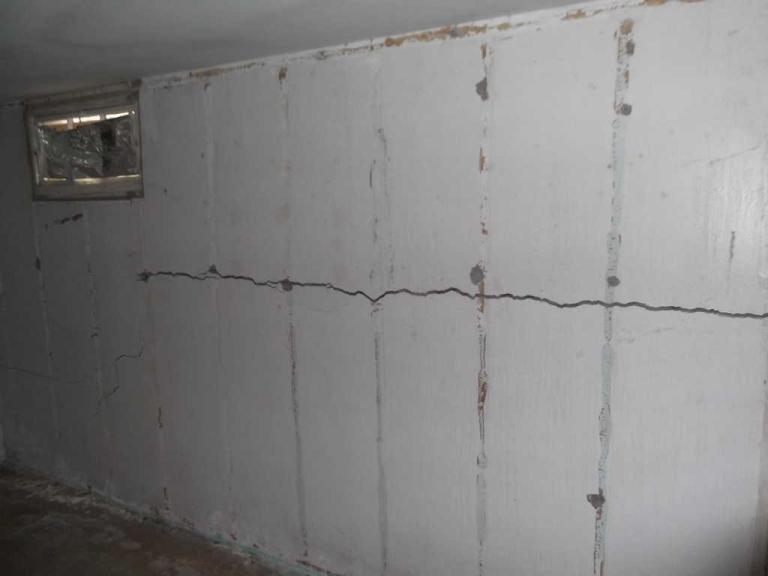
Another type of crack is a horizontal foundation crack. These cracks are almost always structural in nature. These cracks are usually located in the upper third of a concrete or block wall. Often this crack creates a "kinked" wall where it looks like the wall is bulging in at this point. Different types of lateral pressure cause these cracks. Can be cause by driveways and vehicle loading. In freezing climates, they can also be caused by a combination of surface or subsurface water and the frost line. In northern climates, if there are cracked mortar joints in the top third of a block wall or a horizontal crack at about the same depth as the frost line in the area, frost has most likely caused the damage.
Horizontal foundation cracks that are located at mid-wall height on a concrete foundation, block, or stone wall that is bulging inwards at middle height on the wall have probably been caused by vehicle traffic or earth loading. If there’s a driveway near the wall or if the site’s history includes the movement of heavy equipment near the wall, vehicle loading is the likely cause. Backfill damage, such as excessive height or premature backfill before the first-floor framing was in place, is another potential cause of this type of crack. If the home is located on a hillside, earth loading or earth loading exacerbated by water or frost could have caused the cracks. If your home is in an area with wet soil, earth loading or earth loading exacerbated by water or frost could still be the cause.
Next, there are horizontal foundation cracks that are located low on a foundation wall. These are caused because the forces exerted by soils against a foundation wall increase exponentially as you go from the surface level of the soil against the wall to the areas near the bottom of the wall. Essentially, earth pressure is greatest at the bottom of the wall. A wall that has been laterally dislocated at or near its bottom has probably been damaged by earth loading. Horizontal dislocation of a masonry block or brick wall may appear first as a crack and then later as a lateral movement.
